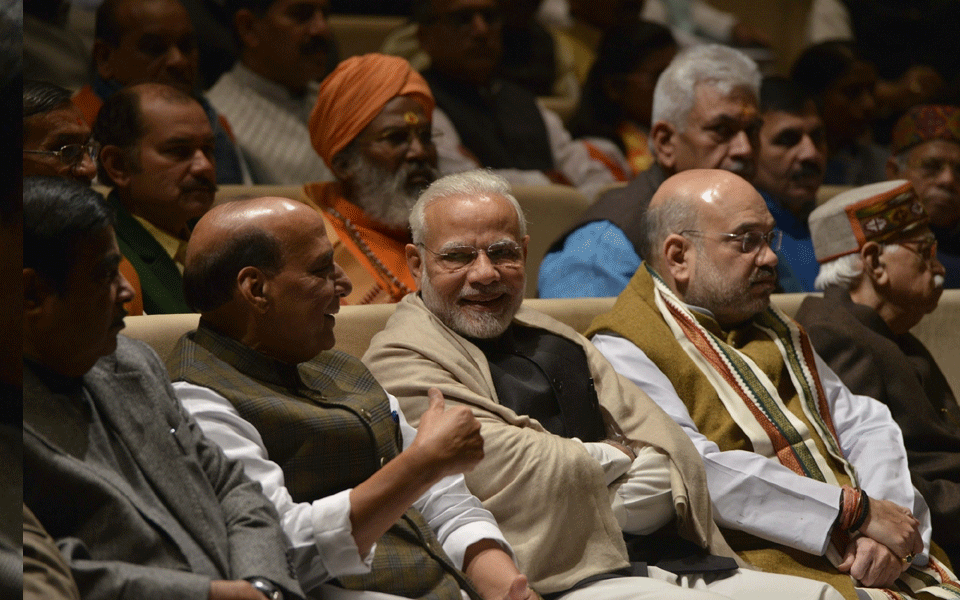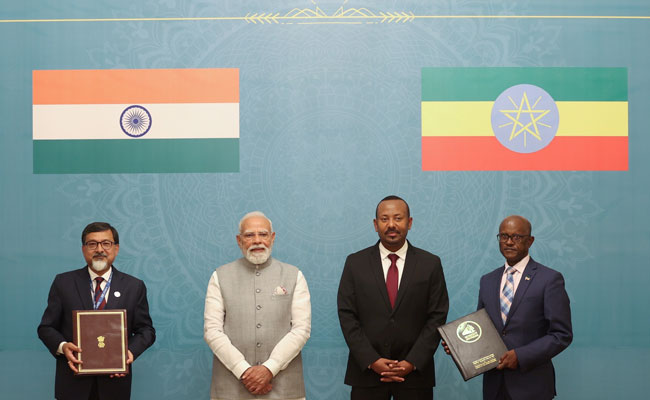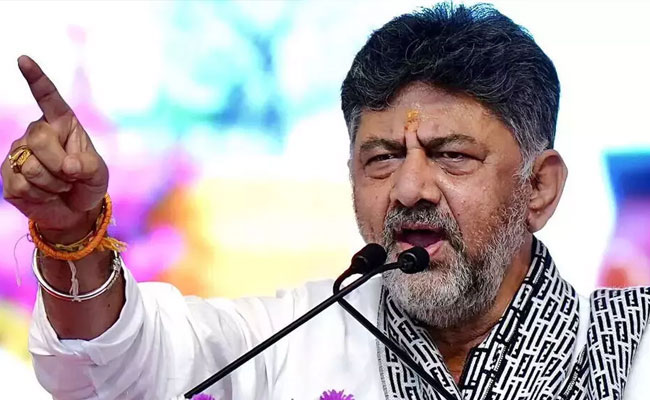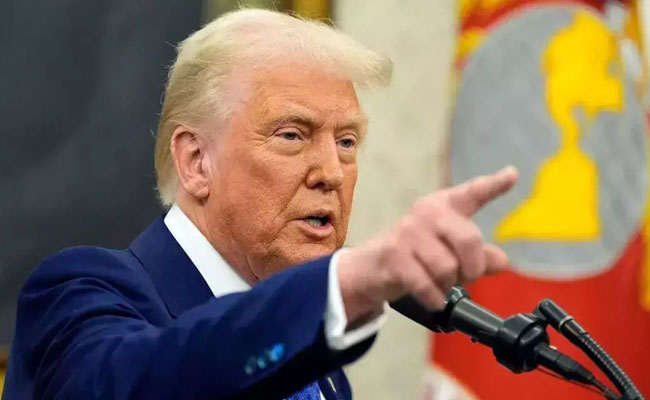There are three aspects of Prime Minister Narendra Modi's speech in parliament -- which was probably his most combative in recent times -- that deserve attention.
First and foremost is the undeniable fact that he is today by far the most effective speaker in Indian politics. His oratory has the potential, therefore, of carrying the Bharatiya Janata Party (BJP) well ahead of the others.
It is such attributes which can have a seminal impact on events. It may not be inappropriate to mention in this context that but for Hitler's rousing eloquence, the Nazis would not have become -- albeit for a decade -- the force that they were in Germany.
However, the success of such declamation lies in a one-sided articulation of a viewpoint devoid of nuances and marked by a blindness to the possible flaws in the presenter's own case. But more of that later. For the present, it is worth noting the second feature of Modi's speech, which was an unrelenting focus on the Congress to the exclusion of all other parties.
What this approach emphasised is that despite the Congress's present weakened condition, it is still perceived by the BJP as a major threat. A corollary to this perception is that the BJP's dream of a Congress-mukt Bharat or an India without the Congress will not be easy for the party to achieve.
What is more, the Prime Minister's speech was a pointer to the political reality that at the national level, a virtual two-party system has come into being in India. The two leading parties may have their allies but, notwithstanding the latter's influences in their local areas, they are no more than appendages to the two main players with little possibility of replacing the two top parties at the Centre.
However, a caveat is necessary at this point. It is that the clout of today's BJP is entirely due to Modi. There is no one else in the party who can take his place. No one can say with certainty how the BJP will fare if he is dislodged. The present primacy of the two parties is heavily dependent, therefore, on personalities (in the Congress's case it is the Nehru-Gandhis) rather than on their respective organisations.
The third aspect of Modi's speech is the stress on the Congress's -- and, as a result, on the country's -- past, since the history of the 132-year-old party is intertwined with Indian history since well before Independence.
As it is, the past played a major role in the BJP's politics considering that its elevation into the mainstream of Indian political life from the margins was based on raking up the depredations of Muslim invaders in medieval times, including the destruction of temples and the building of mosques in their place such as the one in Ayodhya in 1528 on a site regarded as the birthplace of Lord Ram, venerated by Hindus.
From the 16th century to the 20th was but one step for Modi when he put the onus on the Congress for the partition and all that followed, including the division of Kashmir. Modi's contention that the division would not have taken place if Vallabhbhai Patel was the Prime Minister in place of Jawaharlal Nehru was no more than a surmise, but what it underlined was the BJP's current game plan of denigrating at every available opportunity India's first Prime Minister.
The disparagement of Nehru began in Ram Nath Kovind's first speech as the President when he omitted the first Prime Minister's name from the list of those he mentioned, which included Deen Dayal Upadhyaya, the Hindutva brigrade's latest icon about whom little is known to the average Indian outside the Sangh Parivar.
However, nothing showed the bias of the saffron brotherhood more starkly than Modi's refusal to credit Nehru with the establishment of democracy in India since, as he said, democratic principles have marked the country's polity since the time of Lord Buddha.
Even if, for argument's sake, this point is conceded, it would have been interesting if Modi had dwelt on the teachings of Buddha's disciple Emperor Asoka about tolerance -- "one should listen to and respect the doctrines professed by others" -- when a BJP MP, Vinay Katiyar, was reiterating M.S. Golwalkar's diktat about Muslims having no right to live in India when they have carved out of the subcontinent two homelands for themselves -- West Pakistan and East Pakistan (now Pakistan and Bangladesh.
True, the Congress has much to be ashamed of -- dynasticism and corruption being the foremost among them -- but for a Prime Minister to be so ahistorical in his outlook as to believe that the Congress's earlier electoral successes were based solely on the weakness of the opposition and help from the NGOs is odd, to say the least. History is as complex as the reasons for the choice of the people of one party over another.
As a matter of fact, Modi undermined his own case by devoting virtually his entire speech to a party which he thinks should listen to Gandhi's advice to disband itself.
(Amulya Ganguli is a political analyst. The views expressed are personal. He can be reached at amulyaganguli@gmaill.com)
Let the Truth be known. If you read VB and like VB, please be a VB Supporter and Help us deliver the Truth to one and all.
Addis Ababa (PTI): India and Ethiopia on Tuesday elevated their historical ties to a strategic partnership, as Prime Minister Narendra Modi held wide-ranging talks with his Ethiopian counterpart Abiy Ahmed Ali during which they discussed issues of bilateral and mutual interest.
Modi, who arrived here from Jordan on his maiden bilateral visit, was accorded a ceremonial welcome at the National Palace ahead of the bilateral talks, reflecting the vibrant India-Ethiopia relations rooted in shared history and a promising future.
"We are elevating India and Ethiopia relations to a strategic partnership. This step will provide new energy, new momentum and new depth to our ties," Prime Minister Modi said during the delegation-level talks.
He thanked PM Ali for his support in India's fight against terrorism. "The support of friendly countries in this struggle against terrorism holds great significance," Modi said.
"Today, we got the opportunity to deliberate on the key aspects of our cooperation, such as economy, innovation, technology, defence, health, capacity-building and multilateral cooperation. I am pleased that today, we have decided to double the student scholarship for Ethiopia in India," Modi said.
Modi said that India and Ethiopia have shared contact, dialogue, and exchange for thousands of years. The two countries, which are rich in languages and traditions, are symbols of unity in diversity, he added.
"Both countries are democratic powers committed to peace and the welfare of humanity. We are co-travellers and partners of the Global South. On international platforms, we have stood shoulder-to-shoulder," he said.
The two sides signed eight MoUs/agreements, including upgrading ties to 'Strategic Partnership', customs cooperation, establishing data center at the Ethiopian Foreign Ministry, UN Peacekeeping training cooperation, debt restructuring under G20, more ICCR scholarships and AI short courses for Ethiopians, and support for maternal and neonatal healthcare.
Modi said the African Union's headquarters in Ethiopia makes the country a meeting point of African diplomacy. "Inspired by the common vision of an inclusive world, in 2023, India ensured that the African Union became a G20 member," he said.
In 2023, during India’s G20 Presidency, the African Union was admitted as a permanent member of the G20.
Modi said that though this is his first visit, he felt a deep sense of belonging and warmth, reflecting the thousands of years of connection between the two countries.
On his part, Prime Minister Ali said the two countries share over thousands of years of connection through trade, diplomacy, education, culture and even in our food and traditions. "These ties continue to shape a deep friendship, collaboration and mutual respect between our people," he said.
"We also appreciate your consistent message that Africa's priorities must lead the partnership. These kinds of dignified, respectful messages for Africa are very important. Mr Prime Minister, keep pushing. That is the type of message we are expecting from all our trusted friends," Ali said.
He said this aligned fully with Ethiopia's development plan - African-owned, African-led, and African-defined.
"Today, we meet with a clear focus to shape a modern partnership, grounded in sovereignty, self-reliance and practical cooperation. Our cooperation is rooted in equality and South-South solidarity," he said.
"Our economy is performing strongly. Last year, we grew 9.2% and this year we are expecting 10.3% GDP growth. Besides GDP growth, our FDI inflow is also rising big time. India is the leading source for our FDI," he said.
"We have more than 615 Indian companies which are investing in Ethiopia. This all gives our cooperation a strong foundation of trust. I think our decision today that we elevate our historic relationship to a strategic relationship is the right decision," he added.
Ethiopia also conferred its highest award - The Great Honour Nishan of Ethiopia - on PM Modi. He is the first global head of state to receive this award.
Prime Minister Modi also went to the Friendship Park and Friendship Square in Addis Ababa with PM Ali.
In a warm and special gesture, PM Modi was earlier received by his Ethiopian counterpart at the airport and accorded a warm and colourful welcome.
"Ethiopia is a nation with great history and vibrant culture," Modi said.
PM Ali informed his Indian counterpart about the varieties of Ethiopian coffee during informal talks.
"At Addis Ababa airport, took part in a traditional Coffee Ceremony with Prime Minister Abiy Ahmed Ali. The ceremony beautifully highlights Ethiopia’s rich heritage," Modi said.
In a unique gesture, the Ethiopian Prime Minister drove Modi to the hotel.
On the way, he took a special initiative of taking PM Modi to the Science Museum and Friendship Park, which was not in the itinerary.
"Gratitude to Prime Minister Abiy Ahmed Ali for showing me glimpses of Ethiopian history and culture at the National Palace Museum in Addis Ababa. It was a powerful reminder of Ethiopia’s rich traditions," Modi said in a post on X.
The Nobel Peace Prize-winning Ethiopian PM’s special gestures show remarkable respect for Modi, sources said.
"Thank you Ethiopia for a welcome that was unforgettable. The Indian community showed remarkable warmth and affection. India-Ethiopia friendship is going to get even more robust in the times to come," Modi said.
When Modi arrived at the hotel, he was warmly welcomed by the members of the Indian community. Local artists performed dances. Some of them danced on the theme of the popular Hindi song 'Aisa Des Hai Mera' to welcome him.
On Wednesday, Modi will address the Joint Session of Parliament and share his thoughts on India's journey as the "Mother of Democracy" and the value that the India-Ethiopia partnership can bring to the Global South.
PM Modi arrived in Ethiopia from Jordan, where he held a one-on-one meeting with King Abdullah II at the Husseiniya Palace on Monday before the delegation-level talks.
India and Jordan also inked MoUs in the fields of culture, renewable energy, water management, digital public infrastructure and twinning arrangement between Petra and Ellora, aimed at giving a major boost to bilateral ties and friendship.
From Ethiopia, Modi will visit Oman on the final leg of this three-nation tour.





